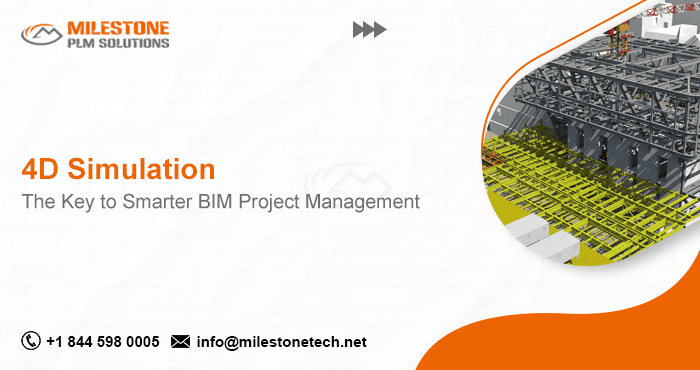4D Simulation: The Key to Smarter BIM Project Management

The construction industry has witnessed a transformative shift in recent years, with Building Information Modeling (BIM) emerging as a cornerstone for efficient and effective project management. However, the true potential of BIM is unlocked when it’s integrated with another powerful tool: 4D simulations.
Understanding 4D Simulations
Before delving into its benefits, let’s clarify what 4D simulations are. While 3D BIM models provide a detailed visual representation of a building, 4D simulations add the crucial element of time. By integrating construction schedules with the 3D model, project managers can visualize the entire construction process as a dynamic, time-lapse simulation. This means seeing how the building evolves over time, from groundbreaking to completion.
The Power of Visualization
4D simulations offer an unparalleled level of visualization, providing several key advantages:
- Early Conflict Detection: One of the most significant benefits of 4D simulations is the ability to identify potential conflicts early in the project lifecycle. By simulating the construction process, project teams can spot clashes between different building elements, equipment, and workers. These conflicts can range from simple interference issues to complex logistical problems. Identifying and addressing these issues proactively saves time, money, and prevents costly rework.
- Optimized Resource Allocation: Effective resource allocation is essential for project success. 4D simulations enable project managers to visualize the distribution of resources over time, such as labor, equipment, and materials. This visual representation helps optimize resource utilization, preventing bottlenecks and ensuring that the right resources are available when needed.
- Enhanced Communication and Collaboration: 4D simulations serve as a powerful communication tool. By sharing the simulation with all project stakeholders, including architects, engineers, contractors, and owners, everyone gains a shared understanding of the project timeline and construction sequence. This fosters better collaboration and reduces the risk of misunderstandings.
- Risk Mitigation: 4D simulations allow project teams to identify potential risks and develop mitigation strategies. By simulating various scenarios, such as delays, equipment failures, or adverse weather conditions, teams can assess their impact on the project timeline and budget. This proactive approach helps minimize disruptions and keeps the project on track.
- Improved Decision Making: Data-driven decisions are crucial for successful project management. 4D simulations provide valuable data on project progress, resource utilization, and potential challenges. This information empowers project managers to make informed decisions, optimize schedules, and allocate resources effectively.
- Increased Stakeholder Buy-in: Visualizing the project’s progress and outcome can significantly enhance stakeholder buy-in. 4D simulations create a shared vision of the final product, building trust and confidence among all parties involved.
Implementing 4D Simulations
To effectively leverage 4D simulations, project teams need to follow a structured approach:
- Create a Detailed 3D BIM Model: A comprehensive and accurate 3D model is the foundation for any 4D simulation. Ensure that the model includes all relevant building elements and information.
- Develop a Comprehensive Construction Schedule: Create a detailed construction schedule that outlines all project activities, their duration, and dependencies.
- Integrate Schedule and Model: Link the construction schedule to the 3D model, assigning specific activities to corresponding building elements.
- Create the 4D Simulation: Use specialized software to generate the 4D simulation, visualizing the construction process over time.
- Review and Iterate: Analyze the simulation to identify potential issues and refine the construction schedule accordingly.
The Future of Project Management
4D simulations are transforming the construction industry by providing a more intelligent and efficient approach to project management. As technology continues to advance, we can expect even more sophisticated simulation capabilities, such as incorporating real-time data, augmented reality, and virtual reality.
By embracing 4D simulations, project teams can optimize resource allocation, mitigate risks, enhance collaboration, and ultimately deliver projects on time and within budget. The future of project management lies in harnessing the power of visualization and data to drive smarter decision-making.
Follow Milestone PLM Solutions for AEC Industry Updates, CAD Tips and Global Construction News.
Milestone PLM Solutions with its exclusive delivery center in India is a global CAD, BIM outsourcing partner serving the needs of the AEC industry since 2004. MILESTONE focuses on the unique needs of clients and believe in tackling real-life problems with efficiency, smooth and ease.
The MILESTONE team can assist you with DD Set, CD Set, BIM Modeling, Rendering, walk through and more. We support multiple BIM software including AUTOCAD REVIT, Architecture cad, Cabinet Vison, Vector works etc. Our approach is to provide a dedicated team for each customer over ongoing project and deliver the quality output consistently.
With our state of art technology and large talent pool of Engineers & Architects, we are developing best in class solutions for our customers across the globe. We align with your culture and values to form unbreakable partnerships and are primed for success with over 100 employees and 150 customers in the US, Europe, India, and Asia.
You can email us at info@milestonetech.net and can log in to our website www. milestonetech.net to know more about our services and our work portfolio or contact us on +1-844-598-0005
